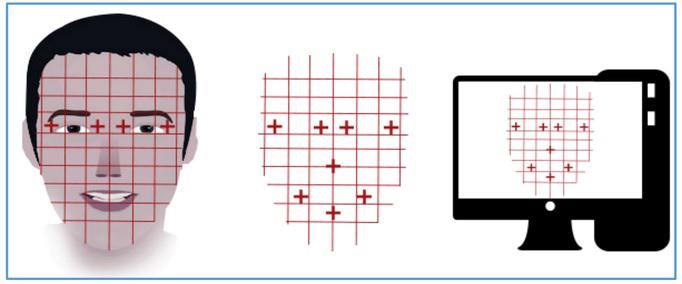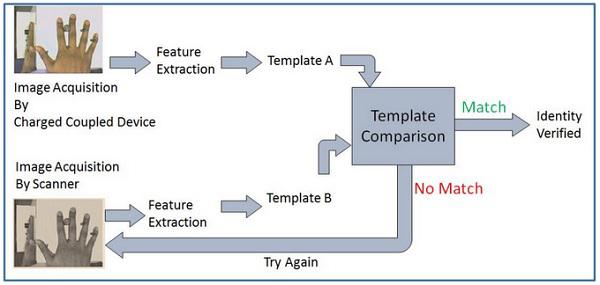Physiological Modalities
As depicted earlier, the physiological modalities are based on the direct measurement of parts of human body such as iris, fingerprint, shape, and position of fingers, etc.
There are some physical traits which remain unaltered throughout a person’s life. They can be an excellent resource for identification of an individual.
Fingerprint Recognition System
It is the most known and used biometrics solution to authenticate people on biometric systems. The reasons for it being so popular are there are ten available sources of biometric and ease of acquisition.
Every person has a unique fingerprint which is composed of ridges, grooves, and direction of the lines. There are three basic patterns of ridges namely, arch, loop, and whorl. The uniqueness of fingerprint is determined by these features as well as minutiae features such as bifurcation and spots (ridge endings).
Fingerprint is one of oldest and most popular recognition technique. Fingerprint matching techniques are of three types −
Minutiae Based Techniques − In these minutiae points are found and then mapped to their relative position on finger. There are some difficulties such as if image is of low quality, then it is difficult to find minutiae points correctly. Another difficulty is, it considers local position of ridges and furrows; not global.
Correlation Based Method − It uses richer gray scale information. It overcomes problems of minutiae-based method, by being able to work with bad quality data. But it has some of its own problems like localization of points.
Pattern Based (Image Based) Matching − Pattern based algorithms compare the basic fingerprint patterns (arch, whorl, and loop) between a stored template and a candidate fingerprint.

Merits of Finger Recognition System
- It is the most contemporary method.
- It is most economical method.
- It is highly reliable and secure.
- It works on a small template size, which speeds up the verifying process.
- It consumes less memory space.
Demerits of Finger Recognition System
- Scars, cuts or absence of finger can hinder the recognition process.
- The systems can be fooled by using artificial finger made of wax.
- It involves physical contact with the system.
- They leave the pattern of finger behind at the time of entering sample.
Applications of Finger Recognition System
- Verification of driver-license authenticity.
- Checking validity of driving license.
- Border Control/Visa Issuance.
- Access control in organizations.
Facial Recognition System
Facial recognition is based on determining shape and size of jaw, chin, shape and location of the eyes, eyebrows, nose, lips, and cheekbones. 2D facial scanners start reading face geometry and recording it on the grid. The facial geometry is transferred to the database in terms of points. The comparison algorithms perform face matching and come up with the results. Facial recognition is performed in the following ways −
Facial Metrics − In this type, the distances between pupils or from nose to lip or chin are measured.
Eigen faces − It is the process of analyzing the overall face image as a weighted combination of a number of faces.
Skin Texture Analysis − The unique lines, patterns, and spots apparent in a person’s skin are located.

Merits of Facial Recognition System
- It offers easy storage of templates in database.
- It reduces the statistic complexities to recognize face image.
- It involves no physical contact with the system.
Demerits of Facial Recognition System
Applications of Facial Recognition System
- General Identity Verification.
- Verification for access control.
- Human-Computer Interaction.
- Criminal Identification.
- Surveillance.
Iris Recognition System
Iris recognition works on the basis of iris pattern in human eye. The iris is the pigmented elastic tissue that has adjustable circular opening in center. It controls the diameter of pupil. In adult humans, the texture of iris is stable throughout their lives. The iris patterns of left and right eyes are different. The iris patterns and colors change from person to person.
It involves taking the picture of iris with a capable camera, storing it, and comparing the same with the candidate eyes using mathematical algorithms.

Merits of Iris Recognition System
It is highly accurate as the chance of matching two irises is 1 in 10 billion people.
It is highly scalable as the iris pattern remains same throughout a person’s lifetime.
The candidate need not remove glasses or contact lenses; they do not hamper the accuracy of the system.
It involves no physical contact with the system.
It provides instant verification (2 to 5 seconds) because of its small template size.
Demerits of Iris Recognition System
- Iris scanners are expensive.
- High quality images can fool the scanner.
- A person is required to keep his/her head very still for accurate scanning.
Applications of Iris Recognition System
- National security and Identity cards such as Adhaar card in India.
- Google uses iris recognition for accessing their datacenters.
Hand Geometry Recognition System
It includes measuring length and width of palm, surface area, length and position of fingers, and overall bone structure of the hand. A person’s hand is unique and can be used to identify a person from others. There are two Hand Geometry systems −
Contact Based − a hand is placed on a scanner’s surface. This placement is positioned by five pins, which guide the candidate hand to position correctly for the camera.
Contact Less − In this approach neither pins nor platform are required for hand image acquisition.

Merits of Hand Geometry Recognition System
- It is sturdy and user friendly.
- The changes in skin moisture or texture do not affect the result.
Demerits of Hand Geometry Recognition System
Applications of Hand Geometry Recognition System
Retinal Scanning System
Retina is the lining layer at the back of the eyeball that covers 65% of the eyeball’s inner surface. It contains photosensitive cells. Each person’s retina is unique due to the complex network of blood vessels that supply blood.
It is a reliable biometric as the retina pattern remains unchanged throughout the person’s life, barring the patterns of persons having diabetes, glaucoma, or some degenerative disorders.
In retinal scanning process, a person is asked to remove lenses or eyeglasses. A low-intensity infrared light beam is casted into a person’s eye for 10 to 15 seconds. This infrared light is absorbed by the blood vessels forming a pattern of blood vessels during the scan. This pattern is then digitized and stored in the database.

Merits of Retinal Scanning System
Demerits of Retinal Scanning System
It is not very user friendly as the user needs to maintain steadiness that can cause discomfort.
It tends to reveal some poor health conditions such as hypertension or diabetes, which causes privacy issues.
Accuracy of the results is prone to diseases such as cataracts, glaucoma, diabetes, etc.
Applications of Retinal Scanning System
DNA Recognition System
Deoxyribo Neuclic Acid (DNA) is the genetic material found in humans. Every human barring identical twins, is uniquely identifiable by the traits found in their DNA, which is located in the nucleus of the cell. There are number of sources from which DNA patterns can be collected such as blood, saliva, nails, hair, etc.
Within cells, DNA is organized in long double helix structure called chromosomes. There are 23 pairs of chromosomes in humans. Out of the 46 total chromosomes, the offspring inherits 23 chromosomes from each biological parent. 99.7% of an offspring’s DNA is shared with their parents. The remaining 0.3% DNA contains repetitive coding unique to an individual.
The fundamental steps of DNA profiling are −
1. Separating the DNA from sample acquired from either of blood, saliva, hair, semen, or tissue.
- 2. Separating the DNA sample into shorter segments.
- 3. Organizing the DNA segments according to size.
- 4. Comparing the DNA segments from various samples.
The more detailed the sample is, the more precise the comparison and in turn the identification of the individual is.

DNA Biometrics differs from all others in the following ways −
Merit of DNA Recognition System
It provides the highest accuracy.
Demerits of DNA Recognition System
- Length of procedure from sample acquisition to result is large.
- Being more informative, it brings privacy issues.
- It needs more storage space.
- Sampling contamination or degradation of sample may affect the result.
Applications of DNA Recognition System
- It is mainly used to prove guilt or innocence.
- It is used in physical and network security.








